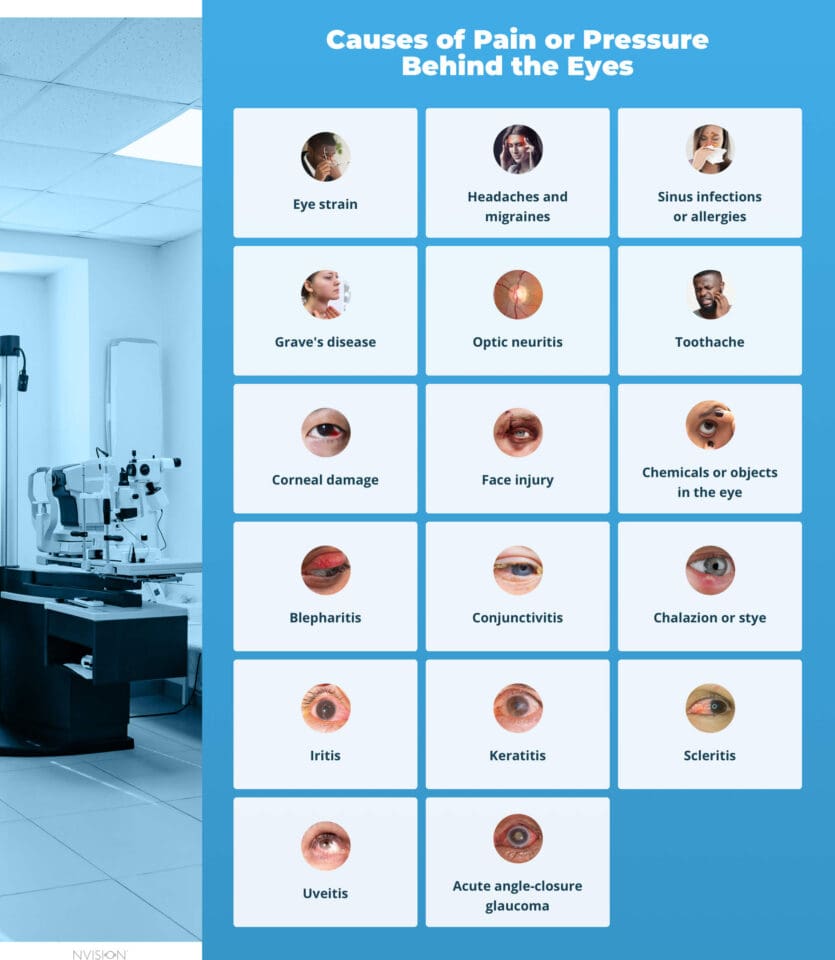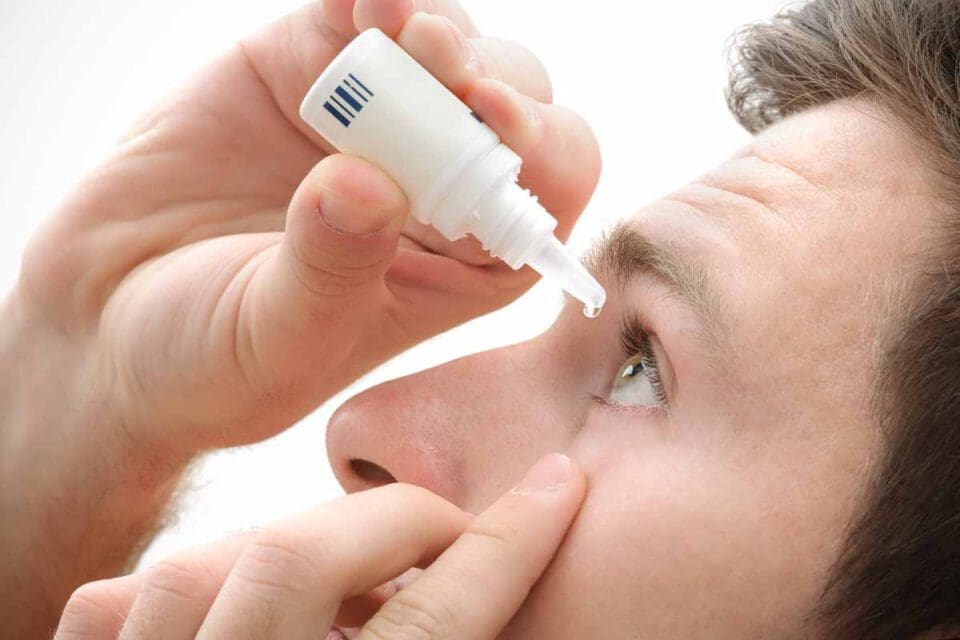
Medically Reviewed by Tom Tooma, M.D., Founder/Medical Director
Pressure or Pain Behind the Eye: Causes & Best Treatments
Home / Eye Health and Preventive Care /
Last Updated:

Medically Reviewed by Tom Tooma, M.D., Founder/Medical Director
Pain and pressure behind the eyes is another common complaint which has a broad number of possible causes and remedies. Like headaches and eye fatigue, pressure behind the eyes is something that everybody experiences from time to time. It can be a trivial bit of discomfort if it’s a one-off, temporary condition, or the sign of more serious problems if it happens regularly.
Here, we’ll sort through some of the common and not-so-common causes of eye pressure. It’s important to know when you should take this as an indicator of serious trouble, and when you can just treat the symptoms and wait for it to pass.
Table of Contents
Pressure or Pain Behind the Eyes Can Be a Symptom Indicating Several Problems
If you experience frequent or constant pressure or pain behind your eyes, there may be a bigger health issue. Visiting an optometrist or ophthalmologist can help, but you may also need to see a physician or a specialist to determine the underlying cause.
Simple eye strain is a common problem in the modern world, since more workers than ever before use computers and other screens. But pain or pressure behind the eyes can also have underlying causes, including chronic and untreated allergies, viruses and bacteria, corneal damage, inflammation of various parts of the eye, and even tumors.
You deserve clear vision. We can help.
With 135+ locations and over 2.5 million procedures performed, our board-certified eye surgeons deliver results you can trust. Your journey to better vision starts here.
Reviewing information on symptoms and treatments can help you understand what is happening with your case, but it is best to work with medical professionals if you are concerned of a bigger underlying problem.

Potential Causes of Pressure and Pain Behind the Eyes
There is quite an extensive list of possible causes for this condition.
While eye pressure and eye pain go together in many conditions, they are different sensations. Pressure will feel like something is pushing on your eye from the back. In contrast, pain can be described as a gritty, dull, shooting sensation, or feeling like something is stuck in your eye socket.
Eye strain: Often, feeling mild pressure or pain behind the eyes can be attributed to eye strain. This condition is not a specific medical diagnosis, but a vague group of symptoms associated with your eyes becoming tired from consistent use. Driving for several hours, reading small print, or working at a computer for a long time can lead to temporarily blurry vision, dry eyes, and feelings of pressure behind your eyes. Dryness from not blinking enough might contribute to feeling itchiness or pain in or behind the eyes.
Headaches and migraines: Pain and pressure around the eyes are common symptoms of headache or migraine. Other symptoms may include a pulsing or throbbing pain in the head, nausea and vomiting, sensitivity to stimuli like light and sound, or seeing flashes of light before the onset of the migraine.
Headaches are often tension-related, which can make feelings of eye strain worse. Migraines may be cluster-based or tension-based. They may or may not make the eyes and other parts of the face hurt.
Sinus infections: The sinuses are positioned around the same region as the eyes. When a condition causes sinuses to fill with mucus, they can put pressure on the surrounding area, leading to pain in the eyes, nose, and around the cheeks. Sphenoid sinusitis specifically is linked to aching behind the eyes. However, other symptoms of sinusitis include runny or stuffy nose, loss of smell, headaches, mucus dripping out of the sinuses and down the throat, fever, coughing, tiredness, and bad breath.
Grave’s disease: Grave’s disease is a condition in which the thyroid gland is overactive. This can have several consequences to your health, and eye pressure and pain can be some of them. Tissues, fat, and muscles all over the body can swell, along with flesh around the eyes. This can cause your eyes to appear to bulge. This may feel like irritation around the eyes, sensitivity to light, eyes tearing up or watering more than usual, dry eyes, double vision, ulcers in the eye, swelling of the eye, being unable to move the eyes, and loss of vision.
Optic neuritis: This condition is caused by inflammation and swelling around the optic nerve, which can cause pain or pressure behind the eye. It may also cause reduced vision, color blindness, blurry sight, pain while moving the eye, and pupils that react unusually to bright light. Optic neuritis usually peaks within a few days and can take a few weeks to improve.
Corneal damage: Abrasions and ulcerations on the cornea can cause pain in or behind the eye. The cornea is on the surface of the eye, and it has pain-sensitive nerve endings. Scratches on the surface of the cornea from trauma, getting something in your eye, or even overusing contact lenses can hurt your cornea. If these become infected, the resulting ulcer can hurt and take longer to heal.
Face injury: Naturally, you should be aware if a facial injury is the culprit behind eye- pressure. Eye socket fractures can damage the muscles, nerves, and sinuses, which can make the eye hurt or feel pressured in turn. You may have a black eye, double or blurry vision, reduced eyesight, numbness around the eye, and swelling in the area that leads to feeling pressure behind the eye, along with possible change in eye shape or appearance.
Blepharitis: Oil glands can get plugged or infected around the edges of the eyelids. This can lead to pain in or behind the eye. Blepharitis can often be linked to certain skin conditions or allergies.
Conjunctivitis: This is another kind of eye infection which can cause eye redness, itching, and swelling. You will need prescription medications to treat the problem. Pressure behind the eye may be a symptom of conjunctivitis, but this eye problem typically does not hurt.
Chalazion or stye: This is local irritation from a lump in or around your eyelid, usually due to a blocked gland in the eyelid, which can cause pressure or pain that radiates from that area. It can be painful to the touch too. Styes more frequently cause pain and sensitivity, whereas chalazions may be painless.
Iritis: Inflammation of the iris, or the colored part of the eye, can lead to pain deep inside the eye, which might feel like it comes from behind the eye. You may also have sensitivity to light, redness, floating spots in the visual field, and blurry vision.
Keratitis: This means painful inflammation of the eye, which might be caused by too much exposure to the sun, bacteria, or the herpes simplex virus. Pain in or behind the eye is the main symptom of keratitis, but sensitivity to light may also indicate you have this.
Scleritis: Inflammation of the white part of the eye, or sclera, is diagnosed as scleritis. Anterior scleritis is the most common form, but posterior scleritis (affecting the back of the eye) may cause pressure or pain behind the eyes. Pain and tenderness are more common symptoms of posterior scleritis, with less redness.
Uveitis: This is a term covering a group of inflammatory diseases that produce swelling and can destroy eye tissues. The uvea is the part of the eye composed of the iris, the ciliary body behind the iris, and the choroid, or tissue surrounding the eye. Chronic uveitis can spread to other parts of the eye, including the retina and optic nerve.
Acute angle-closure glaucoma: This is one of the most serious causes of eye pain and pressure. Severe orbital pain that sets in quickly and a rapid rise in internal eye pressure are signs of this medical emergency. With acute angle-closure glaucoma, you may also experience blurry vision, headaches, nausea and vomiting. If this is not treated, permanent vision loss can occur.
Right Eye, Left Eye, or Both?
Most of the causes of eye pressure will be felt equally on both sides, but some cases, such as infection, will present more in one eye than the other. In general, you should take all cases seriously regardless of whether they affect one or both eyes.
Home Remedy or Diagnosis
In the case of simple eye strain, eye fatigue, headache, or other trivial cause of eye pressure, a simple home cure might be all you need. In any other case, you will need to consult with a physician. In general, the possible causes of eye pressure are far too diverse and serious to dismiss without expert consultation.

Home Treatment
Some milder causes of pressure or pain behind the eye can go away on their own, but if the condition persists or gets worse, you will need to get a diagnosis and start treatment. With severe cases, prompt treatment can mitigate long-term harm.
You can lessen pain by taking nonsteroidal anti-inflammatory drugs (NSAIDs) like ibuprofen or acetaminophen. If you take other prescription medicines, confirm with your doctor that you can mix over-the-counter painkillers with your medication. Some of these over-the-counter options also help to reduce swelling, which eases the sensation of pressure behind the eye.
Medical Treatment
Conditions caused by bacteria and viruses require prescription medication. Eye drops are often prescribed, but you may need to take antibiotic pills or antiviral medicines too.
Bacterial infections usually take about one to two weeks to clear up. Some viral infections, like herpes simplex, are potentially chronic and recurrent, but symptoms can be managed. Outbreaks can be reduced with the right antiviral prescription.
Various other possible causes, such as thyroid issues, might even require general practitioners and treatments that don’t involve the eyes at all.
You deserve clear vision. We can help.
With 135+ locations and over 2.5 million procedures performed, our board-certified eye surgeons deliver results you can trust. Your journey to better vision starts here.
When To Call A Doctor
If any of the following symptoms occur in conjunction with pressure and pain behind the eyes, that means it’s time to schedule a doctor’s visit.
- Sudden, intense pain
- Throbbing pain
- Discharge from the eye
- Abnormal sensitivity to light
- A burning sensation in the eye
- Blurry vision
- Redness in the eye
- Persistent headache
- Fever
- Nausea or vomiting
- Drooping eyelid
Avoid Eye Paid and Pressure
Pressure that is due to migraines and headaches can be avoided by avoiding the triggers to those conditions. Avoid eye strain and fatigue by getting rest or taking breaks from periods of work or intense focus.
If you suffer frequent sinus conditions, you should avoid allergy and irritant triggers. You might even consider relocating to areas with less air pollution if that’s a contributing factor. It may help to sleep with a humidifier at night, to help alleviate sinus swelling and dryness.
And of course, some general whole-body health tips can’t hurt:
- Get consistent sleep – Most eye strain and fatigue issues boil down to not getting a solid eight hours’ rest.
- Stay hydrated – Dehydration leads to headaches and issues with the sinuses and eyes.
- Elevate your head – Sleeping with your head propped up by a few pillows helps your facial tissues to endure less swelling.
In summary, pressure and pain behind the eyes indicates at least a stressful condition, if not a serious medical issue. It’s best to take this symptom seriously and not ignore it, lest a small problem become aggravated into a larger one.
You deserve clear vision. We can help.
With 135+ locations and over 2.5 million procedures performed, our board-certified eye surgeons deliver results you can trust. Your journey to better vision starts here.
References
- What Facts Should You Know About Eye Pain? (October 2019). eMedicineHealth.
- Eye Strain. (November 2019). MedicineNet.
- What Is a Black Eye? (May 2019). American Academy of Ophthalmology (AAO).
- What Is Scleritis? (November 2019). American Academy of Ophthalmology (AAO).
- Uveitis. (July 2019). National Eye Institute (NEI).
- What Are the Symptoms of Glaucoma? (September 2019). Glaucoma Research Foundation.
- What Is Blepharitis? (August 2019). American Academy of Ophthalmology (AAO).
- What Are Chalazia and Styes? (August 2019). American Academy of Ophthalmology (AAO).
- Persistent Iritis, With a Few Twists. (November 2008). American Academy of Ophthalmology (AAO).
- Signs That You May Have a Brain Aneurysm and Need to Go to the ER. (November 2020). St. Luke’s Health.
- Migraine Before Rupture of Intracranial Aneurysms. (February 2013). The Journal of Headache and Pain.
- This Is When to See a Doctor About Eye Pain ASAP. (June 2018). SELF.

Dr. Tooma, the founder of NVISION® Eye Centers, has performed well over 130,000 LASIK surgeries, making him the most experienced LASIK surgeon in the Western United States.
This content is for informational purposes only. It may have been reviewed by a licensed physician, but is not intended to serve as a substitute for professional medical advice. Always consult your healthcare provider with any health concerns. For more, read our Privacy Policy and Editorial Policy.